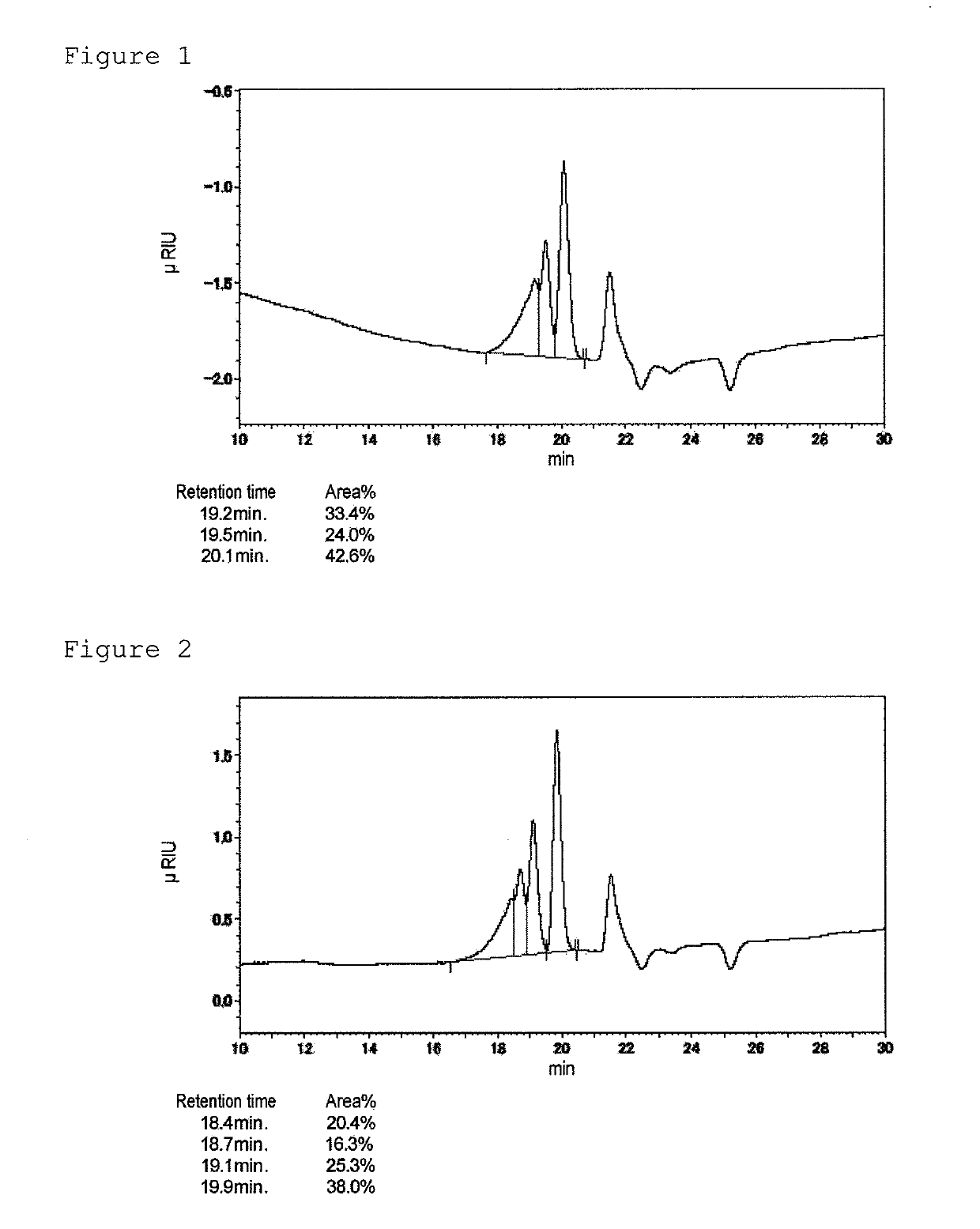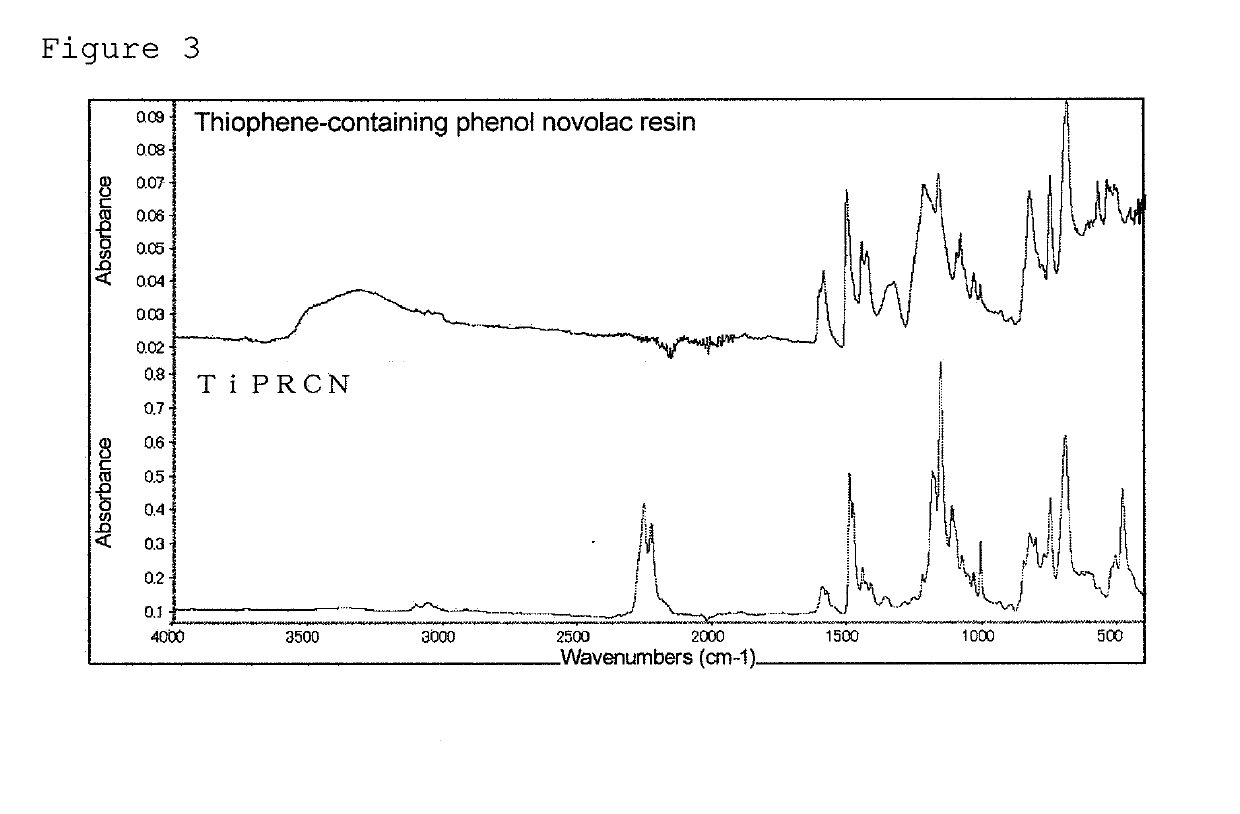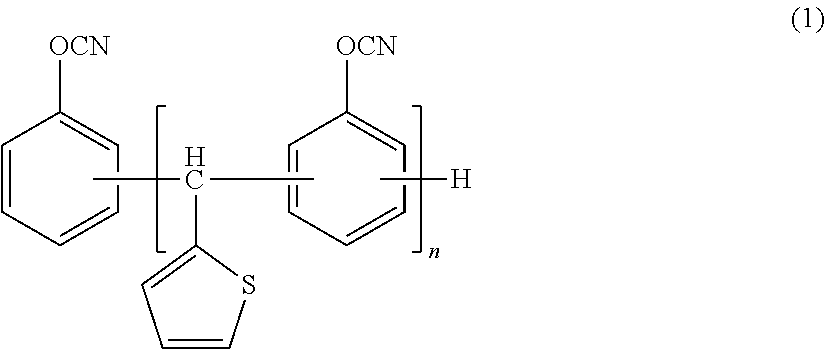Cyanic acid ester compound, method for producing same, resin composition, cured product, prepreg, material for encapsulation, fiber-reinforced composite material, adhesive, metal foil-clad laminate, resin sheet, and printed circuit board
a technology of cyanic acid ester and resin composition, which is applied in the direction of non-macromolecular adhesive additives, organic chemistry, adhesive types, etc., can solve the problems of undesired warpage, unsatisfactory physical properties, and unsatisfactory required properties, and achieve high-performance printed circuits, excellent peel strength, and excellent thermal conductivity.
- Summary
- Abstract
- Description
- Claims
- Application Information
AI Technical Summary
Benefits of technology
Problems solved by technology
Method used
Image
Examples
example 1
Synthesis of Cyanic Acid Ester Compound of Thiophene-Containing Phenol Novolac Resin (hereinafter, Abbreviated to TiPRCN)
[0241]TiPRCN represented by the following formula (1) was synthesized as mentioned later.
wherein n represents an integer of 1 to 20.
[0242]
[0243]First, TiPROH represented by the following formula (2) was synthesized by a method described below.
wherein n represents an integer of 1 to 20.
[0244]113 g of phenol, 28 g of methanol, and 12 g of sodium hydroxide were added, stirred, dissolved, and then heated to reflux. 33.8 g of 2-thiophene aldehyde was added dropwise over 2 hours to the reaction solution in the refluxed state. Then, the reaction solution was reacted at a reflux temperature (90 to 100° C.) for 20 hours and then neutralized with 30 g of an aqueous solution containing 35% by mass of hydrochloric acid, and 5 g of an aqueous solution containing 80% by mass of hydrazine was added thereto. Subsequently, 150 g of methyl isobutyl ketone was added thereto. After r...
example 2
[0250]
[0251]100 parts by mass of the cyanic acid ester compound TiPRCN obtained in Example 1 were added to an eggplant-shaped flask, molten by heating at 150° C., and deaerated using a vacuum pump. Then, the solution was injected into the mold described in JIS-K7238-2-2009, placed in an oven, and cured by heating at 180° C. for 3 hours and then at 250° C. for 3 hours to obtain a cured product of 100 mm in one side and 2 mm in thickness.
example 3
[0266]50 parts by mass of the cyanic acid ester compound TiPRCN obtained by Example 1, 50 parts by mass of a biphenyl aralkyl-based epoxy resin (trade name “NC-3000-FH”, manufactured by Nippon Kayaku Co., Ltd.), and 100 parts by mass of molten silica (trade name “SC2050MB”, manufactured by Admatechs Co., Ltd.) were mixed to obtain varnish. This varnish was diluted with methyl ethyl ketone. Then, a woven fabric of E glass having a thickness of 0.1 mm was impregnated and coated with the dilution and further dried by heating at 165° C. for 4 minutes to obtain a prepreg having a resin content of 50% by mass.
[0267]12 μm thick electrolytic copper foil (trade name “3EC-M3-VLP”, manufactured by Mitsui Mining & Smelting Co., Ltd.) was disposed both above and below eight layers of the obtained prepreg in the direction of lamination, followed by lamination molding at a pressure of 40 kgf / cm2 and a temperature of 230° C. for 120 minutes to obtain a copper-clad laminate (metal foil-clad laminate...
PUM
| Property | Measurement | Unit |
|---|---|---|
| temperature | aaaaa | aaaaa |
| heat resistance | aaaaa | aaaaa |
| reaction temperature | aaaaa | aaaaa |
Abstract
Description
Claims
Application Information
 Login to View More
Login to View More - R&D
- Intellectual Property
- Life Sciences
- Materials
- Tech Scout
- Unparalleled Data Quality
- Higher Quality Content
- 60% Fewer Hallucinations
Browse by: Latest US Patents, China's latest patents, Technical Efficacy Thesaurus, Application Domain, Technology Topic, Popular Technical Reports.
© 2025 PatSnap. All rights reserved.Legal|Privacy policy|Modern Slavery Act Transparency Statement|Sitemap|About US| Contact US: help@patsnap.com



